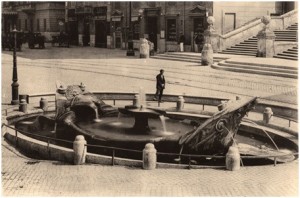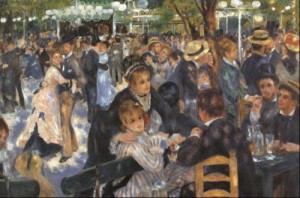Edward Hopper, the man of many movements. Whether it be romanticism, realism, symbolism, or formalism, Hopper has covered them all. I am not going to analyse which oeuvre he was best suited to, nor to which he owes the most allegiance. Instead I am going to try and find the man behind the paintings….
Ok, let’s fast-forward Hopper’s life a little… and hello Josephine! A fellow artist and former student of Robert Henri (a past teacher of Hopper’s), Josephine Nivison was ‘The One’. She was the Simon to Hopper’s Garfunkel, or the Kate to Hopper’s Wills if you want to be a little more current. Model, Manager, Life-Companion, she truly supported her husband (publicly) in every way, which can be seen in the numerous paintings in which Hopper uses her to model various characters and figures.
Hopper has been pigeon-holed several times, from being the illustrator of the all-American way of life (Four Lane Road) to the more complex, dark, detached painter of the more sinister ‘Nighthawks’. However, when asked about his paintings and his particular style of painting, he was noted to reply: “The whole answer is there on the canvas.”
If I can refer you to another statement made by Hopper, we can look at this further:
“So much of every art is an expression of the subconscious that it seems to me most of all the important qualities are put there unconsciously, and little of importance by the conscious intellect.”
He moves us here away from the subconscious of the audience but, instead, to that of its creator – the painter himself. Such being the case, Hopper’s choices and preferences for light and dark are filled with new meaning. If you have a look at one of his more well-known works, ‘Nighthawks’, the dark palette of the street scene combined with the shadows of the well-lit interior presents a sinister tone. No longer do the figures within the diner possess a careless, lonely air, but rather, they become more predatory in appearance. We, as the audience, cannot tell whether Hopper identifies with one of the inner characters, one of the predators, or instead with us, the viewer – always on the outside, looking in.
Indeed, this seems to be a recurrent theme with Hopper. The audience of his work is often treated to the image of a solitary figure, either through a window, or in a state of undress, to which we then have the impression of being voyeurs. The figure (or figures) in the painting is often portrayed as being unaware of the artist/audience. As an example, take a look at ‘Morning in a City’, as modelled by Hopper’s wife Jo. The idea of voyeurism continues. But, with the question of the subconscious ever present, we may start to wonder at this being Hopper’s go-to perspective. Does this mean that Hopper himself feels voyeuristic in painting, or is this a reflection of his feelings when he was amongst his peers in society; that he was on the edge, forever looking in?
We can but guess.

Morning in a City, 1944. Oil on canvas, 112.5 x 152 cm. Williams College Museum of Art, Williamstown, Massachusetts.
So, the mystery of Edward Hopper will have to go a little longer with being unanswered I think. However, one thing we do know for certain is the regard that he bore his wife Josephine. As I have previously mentioned, she was with Hopper for nearly every step of the way; his painting career, his public career, his life! Although perhaps not the most tranquil of marriages (perusal of her private diaries would no doubt lead many stable couples to run screaming ‘divorce! divorce!’ down the streets), it is all the more touching to view Hopper’s final work, ‘Two Comedians’. It shows two actors on the stage of a theatre, taking their last bow. This is increasingly more poignant due to Hopper’s life-long love of the theatre, and upon closer inspection of the figures, we can see that the models are Hopper and Josephine themselves. After Hopper’s death in 1967 (1 year after the completion of ‘Two Comedians’), Josephine confirmed the suspicions of many, that her husband had intended it to portray the end of their life together.
In the end, this is the story that will stay with me from Hopper’s paintings. Outsider or keen observer, it doesn’t matter, what remains in his work is the love story he wrote together with his wife. Tumultuous and stormy maybe, but it is a love story that remains unending.
Venturing to the Grand Palais in Paris between the 10 October 2012 and 28 January 2013 will afford you the chance to catch up with the iconic painter that is Edward Hopper. Discover the early and the mature works of one of America’s finest painters. See for yourselves where his mastery truly lies; with the lighter style of the Impressionists, or with the darker palette of his Rembrandt-fascination. Discover, if you will, his life with Jo, as depicted in his art. Alternatively, feel free to peruse at length ‘Edward Hopper’, written by Gerry Souter.
Ok, let’s talk about the bizarre.
Not the bizarre fascination so many people seem to have with reality shows… TOWIE, My Big Fat Gypsy Wedding anyone? Nor am I talking about the bizarre and scary world which has created the ‘Honey Boo Boo’ phenomenon. Even the Blobfish and the Aye-Aye lose their bizarreness factor when compared to what I’m going to be talking about! (You may want to Google Blobfish and Aye-Aye, just so you get an idea how bizarre this is going to get…)
Ok, I think I’ve created enough suspense. Today folks, allow me to introduce you to Hieronymus Bosch: artist extraordinaire, and possessor of one heck of an active imagination! (Not to be confused with the fictive character of the same name featured in the Michael Connelly books!)
For those of you who may not be familiar with any of Bosch’s work, he created all kinds of mythological and mutant species within his artwork. Some may be recognisable to us from myth and legend, whereas others are entirely figments of his astonishing imagination. Many people have suggested, over the years, that Bosch was one of a series of artists suffering from hallucinations (attributed to ergot poisoning – caused by mould in grain), and so this was the source of his extraordinary characters. Maybe, maybe not. The jury’s out. But, take a look for yourselves:
In one of Bosch’s works, The Last Judgement, we see a triptych of creation – God casting out the rebel angels, Eve being created from Adam’s rib, the serpent (in the shape of a woman…I’m going to go out on a limb and say that Bosch’s view was that Lilith was the serpent) giving the apple, the angel casting the unfortunate couple from the garden. Then we have the Last Judgement. Earth is rife with torments as humanity is shown with all of its sinful nature. Jesus is above this, judging the souls. Finally, on the right-hand side is Bosch’s interpretation of hell, where the wicked souls are punished and demons run rampant with giant fish and what appears to be different types of bird creations…I can see aspects of pelicans and penguins in there, and they happen to be wearing green coats.
Now that’s all well and good, but I’ve seen some of this ‘demons and hell’ creativeness before, in other forms. What is new to me is the ‘Earth’ panel. Virtually indistinguishable from the ‘Hell’ scenario, the colours and landscape blend together seamlessly. And then you look closer. To look at this canvas in person, try and get hold of a magnifying glass! On the computer, make good use of your ‘zoom’!
Perplexing figures of heads on feet, a turbaned head of a man attached to what looks like two spiked shields with a tail and clawed feet (on the top of the roof).
Now look to the bottom right-hand corner. Is that a giant Swiss Army knife? That’s what it looks like to me! Follow that line to the left, and you’ll come across the mutation of a hatching egg (on legs) with an arrow piercing it. In between the egg and the Swiss Army knife is what appears to be a plague doctor (with a stork mask as was common in the period of the Black Death).
If this isn’t confusing enough, see if you can spot the other two eggs in this painting. By their size, in proportion to the rest of the figures, they appear to be ostrich eggs, and are right next to what seems to be a Turkish man, complete with robes and turban. What makes this especially interesting is that this figure seems to be the only one in the ‘Earth’ panel who is clothed (besides the demons), and then you look closer and see that this may not actually be a human after all – the bird claws acting as his feet give him away.
So, what is your verdict? Was Bosch just another artist tripping on mouldy grain, or did he actually have a genius for imagining the bizarre and outlandish that few could hope to match (possibly with the exception of Tim Burton!)?
Undoubtedly one of the more inventive takes on dystopia that I’ve seen for quite some time, I would highly recommend anyone interested in investigating the fantastical to explore the ‘Fables of Flemish Landscapes, Bosch, Brueghel, Bles, Bril’ exhibition being held at the Palais des Beaux Arts de Lille from 7th October 2012 until the 14th January 2013. Myths and legends spring from the canvas in this remarkable collection of paintings, reality is exchanged for artistic license, and paradise and hell are created out of the fantasy one unexpectedly finds in the landscape genre. If you want to brush up on your Bosch before visiting the exhibition, check out our e-book ‘Bosch’ by Virginia Pitts Rembert. Alternatively, explore the full extent of dystopia in ‘Apocalypse’ by Camille Flammarion.
The Musée du Louvre has been in the process of refurbishing their Department of Islamic Art for nearly four years now – expanding to give works of art ranging from India to Spain more, and deserved, space. Reopening the department this month, pieces spanning from the 8th through 19th centuries will be back on display for the masses – it’s about time, guys!
Islamic, Central Asian, and Indian Art are all hugely underrepresented in western cultures. Many museums have one room with a few fantastic pieces devoted to entire eras of the eastern cultures. Which begs the question, should these pieces have even travelled outside of their home counties to places like Paris and New York in the first place? Do these pieces, in fact, belong “at home” where they can truly be appreciated by posterity?

Bowl and cover, c. 1220-1230 or late 13th-early 14th century, Khorasan, Iran. Hammered copper alloy, engraved and dulled decoration, silver and red copper inlays. Musée du Louvre, Paris.
From another point of view, it’s good these pieces have made their way to the west – people that have learned little about Eastern cultures are able to have their interests peaked; and vice versa, Western pieces should make their way into Eastern museums. However, to support my other argument, isn’t the west already, essentially, everywhere in the east? Aren’t young adults choosing different routes than those their parents would want for them based on what they’re seeing on television and in films?
I’ve argued myself in circles and I don’t know what’s right anymore. But until we sort it out, the Louvre has re-opened the doors to their Islamic Art Department and we should all make time to see it. Until my plane ticket arrives in the mail, I’m going to have a closer look at these colourfully illustrated ebooks Art of Islam and Art of India, as well as this Central Asian Art print.
-Le Lorrain Andrews
Vincent Van Gogh: A man of many talents…and many mysteries. Here’s a small list of ‘did you know…?’:
- That he was a teacher?
- That he was a missionary?
- That he was a late-bloomer, artistically? (He didn’t start painting until his late-twenties.)
- That he was an extremely dedicated worker…he produced around 2,100 artworks in about ten years. That works out to 210 sketches/paintings/watercolours/doodles per year! (If you happen to be in possession of any of them, you’d be guaranteed to be an owner of a valuable piece of art!)
- That he was named after his stillborn baby brother?
- That he suffered from mental illness…leading up to the supposed self-inflicted shooting?
- That after he shot himself, he was able to walk back to his hostel, and was left smoking a pipe by two physicians who told him they couldn’t remove the bullet?
- That he survived for 29 hours after he was shot?
- That there is a theory that somebody else shot him, because the gun was never found?
And, for the purposes of this article:
That he was a ‘the grass is always greener…’ sort of guy.
Allow me to explain. For me, it’s usually: ‘I wish I was taller. Then I’d be able to wear those shorts, that dress, yadayadayada.” You know what I mean, everybody has something they wish was different, or wish they had. Van Gogh, or Vinnie to his friends, was no different. But for him, the green-eyed monster appeared through an unlikely source: that of Japanese ukiyo-e wood block prints. About the time that he was in Paris, Vinnie discovered this form of Japanese art, and fell in lust. He collected hundreds of these prints, but collecting wasn’t enough. He wanted to own this form of artwork, and create it himself. So, Vinnie did the equivalent of what I do to make myself taller. (No, he didn’t buy a new pair of ultra-high stilettos.) He copied existing Japanese wood-prints! Now, some people might want to throw the word ‘plagiarism’ around, some may want to commend him on his source of inspiration. Whatever, I’m not judging. I will say, that Vinnie’s three notable works in the ‘Japonisme’ style are incredibly detailed, bold and masterfully executed. Of course they are – it’s Van Gogh!
However, finding out that one of the greats was as susceptible to a bit of peer-envy as I myself can be, well, I just find that selfishly reassuring.
But, please, don’t just take my word for it! If you want to get up close and personal with Van Gogh and his work, and sneakily compare his take on Japanese ukiyo-e with the real deal, I strongly recommend that you make a trip to the Pinacothèque de Paris. The dual exhibition of ‘Van Gogh et le Japonisme’ is on display from 03 October 2012 to 17 March 2013. If Paris isn’t your scene – or you simply would rather wait until springtime (although Frank Sinatra does then go on to sing about how he loves Paris in every season), then you may be interested in looking up Vincent Van Gogh, written by Victoria Charles.
The 17th century was a busy one. Full of territorial disputes around the world, English colonisation of the Americas, Japanese isolation, the fall of the Ming Dynasty in China… I could go on. But I won’t. More importantly, the world was (still) heavily focused on religious art, though many artists started to branch out and become a bit more narcissistic, here’s lookin’ at you Rembrandt and your many self-portraits.
Do you know what else came to be in the 17th century? Ice cream. You (probably) read it here first! No proper recipe for ice cream, though various other versions previously existed in Persia, China, and Italy for example, appeared until 1674 in France.
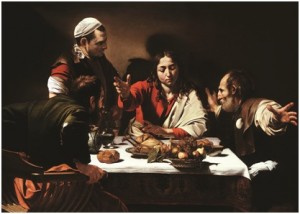
“Welcome back! Could we get a little creamed ice after this lovely meal, JC?” Michelangelo Merisi da Caravaggio, Supper at Emmaus, 1601. Oil and tempera on canvas, 141 x 196.2 cm. The National Gallery, London.
Are you thinking what I’m thinking? Surely the invention of ice cream stirred a deeper belief in God and Jesus Christ – who or what else could inspire such a cold, creamy, delicious treat? Could it be that artists of the time were so overjoyed with appreciation that they could find no other way to express their praise except to paint on the canvasses closest to the Heavens at the time: ceilings?
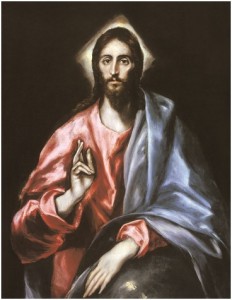
“Bless you, child. Go forth and enjoy ice cream; but eat slowly or you will get a brain freeze.” El Greco, The Saviour, 1610-1614. Oil on canvas, mounted on wood, 100.4 x 80.2 cm. Museo del Greco, Toledo.
The Musée Carnavalet is exhibiting The Colours of Heaven now through 24 February 2013, a collection of paintings, drawings, and engravings devoted to Paris’ many churches. Don’t worry; you won’t have to crane your neck to look upwards too much. And if you’d like to see more religious devotion, check out the beautifully illustrated ebook, Christ in Art by Ernest Renan.
-Le Lorrain Andrews
When I think of the relationship between Russia and Germany the first thing that comes to mind is Carrie and Mr Big or maybe Ross and Rachel for those of you that never dug into Sex and the City – in which case, shame on you. The on-again, off-again saga of their affairs is almost too much for the common person to handle.
They’re on – they’re politicking together and mutually militaristic; Russia is sharing her energy sources because of her dependence on Germany’s finances. If that’s not a relationship, I don’t know what is! And then Leo von Caprivi had to go and cut Russia out, ruining the three-way alliance with Austria. Certainly, they were on a break!
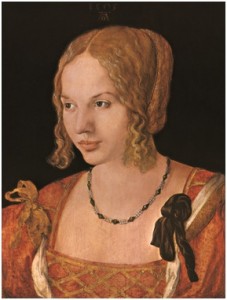
Albrect Dürer, Portrait of a Young Woman, 1505. Oil on wood, 26 x 35 cm. Kunsthistorisches Museum, Vienna.
They’re off – they’re warring against each other in WWI, ending with Germany helping to send in the dogs – rather Vladimir Lenin.
Shortly thereafter, they are back on due to social stigmatisation from the rest of the world, which is quickly ruined with Germany’s anti-Communist, anti-Slav rhetoric and Hitler’s invasion of the Eastern Front – leading to the bloodiest conflict in history. I think we can all agree Germany wasn’t the nicest kid on the block during this time.
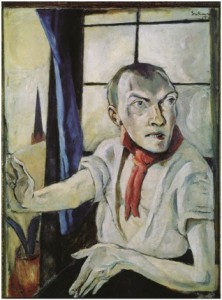
Max Beckmann, Self-Portrait with a Scarf, 1917. Oil on canvas, 80 x 60 cm. Staatsgalerie Stuttgart, Stuttgart.
Slowly the two realised they had more in common than not after the fall of the Wall and Socialism. They’ve managed to remain amicable over the past 30 years – not discussing their differences, but revelling in their similarities.
It is in their similarities that we are able to see marks of Russia in Germany’s art, history, and culture, and vice-versa. Positive spurts and splashes of colour and light, sound and beauty, harmony between the two cultures. And isn’t that all the world needs right now? Harmony amongst the masses, a sharing of art and culture?
Go see Russians & Germans. 1000 Years of Art, History and Culture, on at the Neues Museum, now through 13 January 2012, for the nuances of the tumultuous millennium-long love affair between these two fascinating countries. Also, keep an eye out for German Painting by Franz Dülberg for even better insight into their artistic relations.
-Le Lorrain Andrews
Rome is the city of light, certainly, but it is also the city of water. Tourists may visit for the city’s celebrated history and architecture, but they leave entranced by the babbling fountains which dot the city like stars. What most don’t realize is that most of those fountains were designed by the same man: the astoundingly talented Gian Lorenzo Bernini.
Immortalized in countless great works of cinema, from Frederico Felini’s La Dolce Vita to Woody Allen’s To Rome With Love, Bernini’s fountains are essential to the character of this most romantic of cities. His Fontana della Barcaccia on the Spanish Steps even provided the backdrop for Gregory Peck and Audry Hepburn to meet cute in Roman Holiday, and has been photographed by countless tourists attempting capture a uniquely Italian image. In many ways, modern Rome is the city Bernini built.
Still, as influential as he is today, Bernini’s path to artistic immortality was not smooth. In the seventeenth century when he was a young man he was quite a controversial figure, his artistic genius at times overshadowed by the scandals that surrounded him.

Gian Lorenzo Bernini, Self-Portrait as a Young Man. c. 1623. Oil on canvas, 62×46 cm. Galleria Borghese, Rome, Italy
Bernini was the darling of the art world from the age of eight, when Pope Paul V boasted that the child would be “The Michelangelo of his century.” And as he grew up, and his skills increased, so did his social success. Beloved by the wealthiest families in Italy, and a favourite of the church, Bernini led a charmed life. At least, until he met Constanza Buanerelli.
Constanza was the wife of Bernini’s assistant Matteo, a young and lovely woman whose freshness and charm immediately won over the artist. He was inspired by her sensuality, and she quickly became his muse, her post-coital rumple immortalized in stone in one of his most celebrated busts.

Gian Lorenzo Bernini, Bust of Constanza Buonarelli. c. 1635. Marble, 72 cm. Museo Nazionale del Bargello, Florence, Italy
Alas, their happiness was brief. Bernini was an extremely jealous lover, infuriated that he was forced to share Constanza with her husband. He repeatedly insulted the hapless Matteo to such a great extent that his affair with Constanza became a matter of common knowledge, and she was jailed for adultery. Protected by his powerful friends, Bernini himself got off scot free.
Constanza, tired of her lover’s covetousness, took her revenge by beginning an affair with his brother. Enraged, Bernini followed the pair to the steps of St. Peter’s basilica, the Pope’s seat of power, whose interior he had so masterfully designed years before. He beat his brother half to death with an iron rod, and bribed a servant to slash Constanza’s face with a razor, destroying the beauty that had once captivated him.
Pope Urban VIII used his power to get Bernini out of trouble, even excusing the 3000 scudi fee the court leveled against him. But the pope was tired of helping the bad boy artist out of romantic scrapes, and this time his help came with a price. He forced Bernini to marry a virtuous woman of the church’s choosing, a union that was by all accounts a happy one, lasting decades and producing eleven children.
Still, Bernini never sculpted his wife. Maybe he had learned his lesson with Constanza, his great love and his muse, whose faithless beauty he so fatally immortalized.
Those of you lucky enough to be in New York should make sure to check out Bernini: Sculpting in Clay at the world famous Metropolitan Museum of Art from October 3, 2012 to January 6, 2013. Or to follow along at home, and get critical insight into Bernini’s controversial life and work, check out our ebooks on Sculpture and Baroque Art, both written by celebrated art historian Victoria Charles.
-George Kostrowitzky
Where do you go when you are looking for the latest fashion designs? Or want to see what is à la mode on the High Street? Or perhaps, just want to see what’s going on in the city? Well, the internet. Right? Or a fashion magazine.
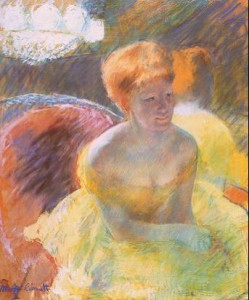
At the Theatre, c. 1879. Pastel, 53.3 x 43.2 cm. The Nelson-Atkins Museum of Art , Kansas City, Missouri.
I think that if we were to be suddenly transported to the 19th Century we would be in for a big culture shock! No internet, no modern conveniences…and yet, society of the 19th Century, in some respects, is considered to be more cultured and sophisticated than our own. More genteel, certainly! Impressionists such as Renoir, Cassatt, and Monet: these were the people who were responsible for providing society with images of the latest fashion trends. Cassatt, for example, painted theatre-goers. The who’s who of Paris fashion attended these soirees, so it is not far out of the realms of possibility that these paintings would be consulted by the fashionably elite to check out what was being worn, where and by whom…remind you of any of our celeb magazines now?
Pierre Auguste Renoir was busy capturing life in the moment – the lively scene in the ‘ball at the moulin de la gallete’ is so busy, you can practically see the movement and hear the buzz of conversation. The impressionists were offering an alternative to the black and white photography of the day. It was not a direct competition, but what they could do that the photographers couldn’t was to offer a subjective, colourful view of day to day life.

Woman with a Pearl Necklace in a Loge, 1879. Oil on canvas, 81.3 x 59.7 cm. Philadelphia Museum of Art, Philadelphia
Final thought before I finish: In their day, the Impressionists were viewed contemptuously by the members of the jury of the Salon. Their work was rejected and ridiculed due to the colours that they employed and the thick brushstrokes that they used. Mary Cassatt was even criticised for painting her subjects too realistically to be flattering. This makes me wonder – we now rely on the Impressionists’ work for a sense of the culture, fashion and way of life in the 19th century. In another couple of centuries, are today’s paparazzi going to be admired as much as we admire the Impressionists? Because, let’s face it, they too offer a glimpse into culture, celebrity fashion and day-to-day activities. They are also not highly regarded by many people in today’s society… so you see, there are links to be made between the two!
For a broader look into 19th Century life and fashion, check out the ‘L’impressionisme et la mode’ exhibition at the Musée d’Orsay, being held between the 25th September 2012 and 20th January 2013. Or, if you just want to be enchanted by a simpler time and appreciate the elegance and gentility of the 19th Century from the comfort of your technologically advanced home, take a look at Nathalia Brodskaya’s Impressionism.
Andy Warhol is easily one of the most interesting people to have ever lived. I say this having known next to nothing about him other than his over-exposed, colourful reproductions of 1960s-1980s popular culture, all of which I found excessive, superficial, and ridiculous, up until two hours ago.
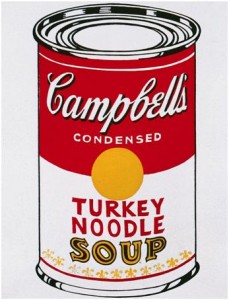
Screened in accordance with Warhol’s long-time lunchtime devotion to the brand. Andy Warhol, Campbell’s Soup Can (Turkey Noodle), 1962. Silkscreen ink on canvas, 51 x 40.6 cm. Sonnabend collection.
But wasn’t that essentially his intention, to explore popular culture? Spending most of his time at home as a young child and teenager, Warhol listened to the radio (and the adverts) and collected photos of film stars; he was greatly influenced by the growing popular culture of the 1950s. Starting his career as a commercial illustrator should come as no surprise to anyone, nor should the fact that, unlike other artists, he basked in the spotlight of fame that came from the success of his commercial art.
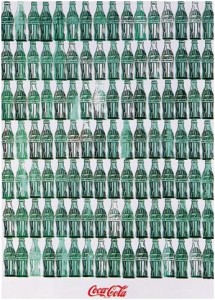
Screened for his appreciation of the wide-spread appeal of Coca-Cola – for the rich as well as the poor! Andy Warhol, Green Coca-Cola Bottles, 1962. Synthetic polymer, silkscreen ink, and graphite on canvas, 209.2 × 144.8 cm. Whitney Museum of American Art, New York.
Endlessly and un-sarcastically praising the plasticity of Hollywood, I’m convinced all Warhol wanted was his “fifteen minutes of fame” (did you know he coined that?). Little could he have ever imagined we’d still be fawning over his bright colours, cow motifs, and his Pope of Pop-(Art)dom over twenty years after his death. Though I think he’d be less impressed with the reality of what “fifteen minutes of fame” has afforded us by way of reality television (Jersey Shore and Honey Boo Boo, anyone?).
What are you waiting for? Get over to the Met now through year’s end to see Sixty Artists, Fifty Years and relish in the expansion of Pop Art over the years. Then, get these ebooks for a little at-home inspiration: Warhol by Eric Shanes and Warhol by Gerry Souter.
-Le Lorrain Andrews
When you think of “Pre-Raphaelite”, what comes to mind? For me, it is male painters, female subjects, a lot of nature, and vivid colours. And for 95% percent of paintings produced by this movement, this is the reality.
The key members of the group (Hunt, Millais, the two Rossettis, Collinson, Stephens, and Woolner) were all men. Together, they created a secret group called the Pre-Raphaelite Brotherhood. Like just about every other artistic movement, the Brotherhood wanted reform. They rejected the academic styles of Raphael and artists after him, finding them idealised and corrupted. The Brotherhood sought a return to the Pre-Raphael Italian style with its vivid colours and imitation of nature.
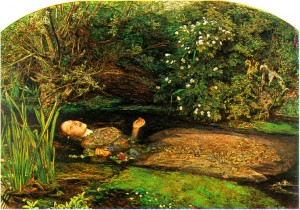
Sir John Everett Millais, Ophelia, 1851-1852. Oil on canvas, 76.2 cm × 111.8 cm. Tate Britain, London.
The Pre-Raphaelites insisted on painting nature from direct observation to ensure it was depicted with accuracy and detail. Millais even stood outside for four months painting the background of one of the most well-known paintings of the movement, Ophelia (above). After he painted the landscape, he had the model for Ophelia lie in a full bathtub in his studio. But who was this model whose face is now so well-known? Her name was Elizabeth Siddal, and she eventually became a Pre-Raphaelite artist as well, which brings us to the exceptions to the 95% rule I mentioned earlier: the female artists who successfully joined the “brotherhood.”
Elizabeth Siddal was one of several model-turned-artists of the Pre-Raphaelite movement. She was a model for almost all of the members of the Brotherhood, and was the primary subject of Rossetti (who was said to have painted Siddal thousands of times). It’s no surprise that Rossetti and Siddal became lovers and eventually married. Rossetti taught Siddal to paint; she caught on quickly and developed her own unique style. Her self-portraits (see below) are interesting because one can compare how she perceived herself as opposed to how she was perceived by the artists she modelled for. Her other paintings (such as The Ladies’ Lament, below) are characteristic of the Pre-Raphaelite movement, with their focus on nature, vivid colours, and realistic subjects.
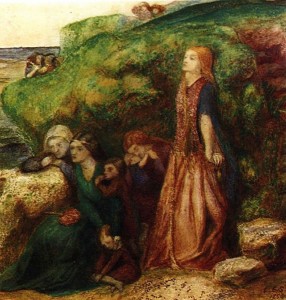
Elizabeth Siddal, The Ladies’ Lament, 1856. Watercolour on paper, 241 x 229 mm. Tate Britain, London.
Siddal was not the only female Pre-Raphaelite artist. Another notable woman from the movement was Rosa Brett, who was taught to paint by her brother, John Brett, and focused on painting landscapes. In fact, there are at least twenty others. Several of them, including the celebrated Jane Burden Morris, were also models-turned-lovers-turned-artists like Siddal.
Although these 19th century women did not have access to their own formal art education, they found other ways to learn. Luckily for them, the Brotherhood was actually quite forward-thinking in their attitude towards female painters, who they welcomed into their circle. Despite the implied gender in the name, the Pre-Raphaelite Brotherhood was a movement that enabled women to pursue their passions and do more than just pose for paintings. Women were finally beginning to establish themselves in the artistic world.
If you are in London before January 13, 2013, make sure to check out the exhibition on the Pre-Raphaelites at the Tate Britain. You may be distracted by the amazing paintings by the Brotherhood, but keep your eye out for the 5%—the ones done by the women. If you can’t make it to the exhibition or just want to learn more about this movement, check out our ebook.
By Category
Recent News
- 04/03/2018 - Alles, was du dir vorstellen kannst, ist real
- 04/03/2018 - Tout ce qui peut être imaginé est réel
- 04/03/2018 - Everything you can imagine is real
- 04/02/2018 - Als deutsche Soldaten in mein Atelier kamen und mir meine Bilder von Guernica ansahen, fragten sie: ‘Hast du das gemacht?’. Und ich würde sagen: ‘Nein, hast du’.
- 04/02/2018 - Quand les soldats allemands venaient dans mon studio et regardaient mes photos de Guernica, ils me demandaient: ‘As-tu fait ça?’. Et je dirais: “Non, vous l’avez fait.”
















